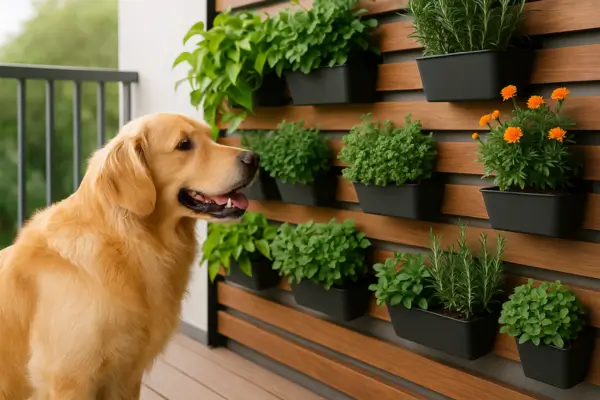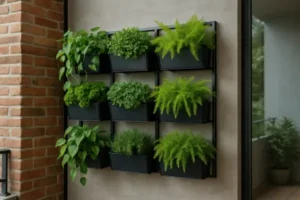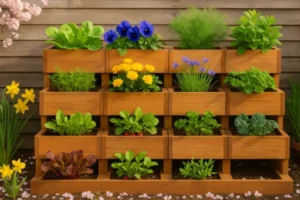Dog-proof vertical gardens are a smart way to enjoy plants without giving up space to your dog. If you’ve ever tried to balance greenery with a curious pup, you know the challenges—chewed leaves, spilled soil, and nose prints where you didn’t expect them.
Vertical gardens offer structure, height, and separation—all things that make it easier to create a shared balcony that actually works. With the right setup, your plants stay intact and your dog has room to roam.
In this article, you’ll find ideas that go beyond the basics. We’ll cover layout strategies, plant choices, and design tips to help you create a balcony that feels good for both you and your dog.
Dog-Proof Vertical Gardens: Why the Right Structure Matters
When planning dog-proof vertical gardens, structure isn’t just important—it sets the tone for everything else. The way your garden is arranged, supported, and anchored can be the difference between something that thrives and something that’s constantly being knocked over or chewed on.
Most dogs are curious by nature. If your garden seems unstable or easy to reach, your dog will likely treat it as an open invitation. That’s why starting with a strong, intentional structure is essential. A system that’s too low, loosely built, or swings with movement can quickly become a problem.
Key Structural Elements That Help
- Height matters: Mounting the first level of your garden at least 18–24 inches above the floor keeps it out of a dog’s immediate line of interaction—especially for medium to large breeds. For smaller dogs, even 12–16 inches can help.
- Material choice: Lightweight plastic units may look neat but often wobble under stress. Instead, choose powder-coated steel, weather-treated wood, or recycled composite frames designed to handle a bit of weight and motion. These materials also resist scratching and chewing far better than soft plastic or rope-based setups.
- Stable base design: If your vertical garden is freestanding, anchoring it with planters or weights at the bottom can help. Some modular systems allow for integrated bench seating or storage at the base—which adds weight and doubles as a pet-friendly barrier.
- Placement in corners or near walls: Positioning your garden along a wall or in a corner minimizes access points and gives natural support. Wall-mounted gardens are even better—they stay fully off the floor and don’t shift when bumped.
- Avoid open lattice backs: Dogs may try to reach behind or through the structure. A solid panel or closely packed vertical grid discourages this behavior and helps define a visual boundary.
Taking time to get the structure right from the start will save you a lot of frustration later. It also gives your balcony a more finished, intentional look—which helps your dog learn what’s off-limits without constant correction.
Design Tips That Make a Real Difference
Once the structure is in place, small design choices can make a big difference in how your vertical garden holds up over time—especially with a dog sharing the space. Design is not only about looks; it also helps set expectations for how the space should be used.

A thoughtful layout sends subtle signals to your dog: “This area is not for playing.” It also makes maintenance easier and reduces the chance of something being knocked over or chewed on during a curious moment.
Here are a few design strategies that work especially well for dog owners:
- Wall-mounted or anchored designs
These provide the most stability. Choose brackets that secure firmly to balcony railings or external walls, so the garden doesn’t shift if your dog brushes past. Hanging designs may look elegant, but they’re easier to bump and sway with movement—making them more tempting. - Built-in base supports
A raised bottom tier made of solid wood, storage benches, or planter boxes not only adds weight but creates a strong “base” your dog won’t bother with. It also acts as a visual boundary that separates your dog’s zone from the greenery. - Compact planting with little open space
Leave less room between planters and leaves. When foliage is tightly spaced, dogs have less interest in poking their noses in. Open gaps tend to feel like play tunnels. Dense planting also helps the garden feel more cohesive and less like a row of unrelated items. - Tough zones at the bottom
Keep the lowest row free of delicate herbs or leafy greens. Use it for tough, textured plants like ornamental grasses, succulents with hard leaves, or even non-living decor like pebbles, river rocks, or decorative tiles. These elements create a buffer without inviting attention. - Consistent layout signals
If your garden looks intentional—symmetrical, balanced, and clearly framed—your dog will interpret it as a fixture, not a toy. Random pots placed unevenly can seem like movable objects to a pet that’s used to interacting with the space.
When a space feels structured and calm, dogs naturally adapt to it. They respond to rhythm and repetition. The more consistent your garden looks, the less likely it is to trigger unwanted behavior.
Understanding Dog Behavior Around Plants
Every dog is different, but most share a few predictable habits when they encounter plants: sniffing, chewing, digging, and rubbing against leaves or containers. When setting up dog-proof vertical gardens, recognizing these patterns early helps you make better decisions before problems start.
Dogs explore the world through scent, texture, and movement. Fresh soil, rustling leaves, and earthy or herbal smells grab their attention right away. A plant swaying slightly in the wind might look like a toy. Loose soil might feel like an invitation to dig. And soft leaves can seem chewable—especially to young dogs still learning what’s allowed.
Some breeds—like terriers, retrievers, and herding dogs—have stronger instincts to interact with the ground. But even calmer breeds can develop habits around plants if they’re bored or looking for stimulation. Chewing, in particular, is often linked to excess energy or lack of environmental enrichment.
If your dog tends to interact with the garden, observe when and how it happens. Is it right after you water? When you’re not around? Or when the balcony is quiet? Noticing these details gives you clues on how to adjust the garden layout, timing, or access—so you’re working with your dog’s natural rhythms, not constantly trying to fight them.
What Drives the Curiosity?
Before assuming your dog is being “naughty,” it’s helpful to consider why they’re drawn to your plants in the first place. Dogs aren’t trying to ruin your garden—they’re reacting to what it offers through scent, texture, and movement.
Here are a few common reasons dogs show interest in vertical gardens:
- Boredom or lack of stimulation
When left alone or under-engaged, dogs often look for something to do. A plant with moving leaves or loose soil becomes an easy source of entertainment. - Scent-driven exploration
Dogs follow their noses. Fresh potting mix, aromatic herbs, and organic compost materials can trigger intense sniffing, licking, or digging behaviors. - Comfort and texture-seeking
Some leaves, mosses, or liners feel good on the gums—especially for puppies in the teething phase or dogs that enjoy tactile play. The texture of soft plants or dangling vines may invite gentle mouthing or rubbing.
Learning from Observation
Instead of reacting after the damage, try watching how your dog interacts with your setup. Are they only curious after watering? Do certain types of plants get more attention? Are they drawn to lower tiers or specific materials like coconut coir, mulch, or moss?
Small changes based on those observations can help redirect curiosity:
- Move strong-scented plants or delicate textures to upper rows
- Avoid loose fillers like mulch or coir near the floor
- Use tougher, less aromatic plants in the dog’s visual zone
The more you observe, the better you’ll understand your dog’s preferences—and the easier it becomes to design a garden they’ll learn to ignore naturally.
Choosing the Right Plants for Dog-Proof Vertical Gardens
Not every plant belongs in a balcony shared with a dog. Some are tempting, others are too delicate, and a few are best kept out entirely. When creating dog-proof vertical gardens, the plant list matters just as much as the design.
You’re looking for greenery that holds up well to occasional contact, doesn’t drop messy debris, and most importantly—won’t cause harm if your dog gets curious. Hardy leaves, upright growth, and mild or neutral scents are all good starting points.
Dog-Friendly Plants That Work Well in Vertical Setups
Here’s a list of plants that tend to do well around dogs and fit nicely into modular vertical systems:
- Spider Plant (Chlorophytum comosum)
Easy to grow, non-toxic, and handles a bit of rough air movement. - Boston Fern (Nephrolepis exaltata)
Visually full, safe for dogs, and tolerant of low light—perfect for shaded balconies. - Areca Palm (Dypsis lutescens)
Tough and elegant, with soft fronds that don’t easily snap or tear. - Herbs like Basil, Thyme, and Dill
Great for cooking, pleasant-smelling, and generally safe for dogs when grown in moderation.
Plants to Avoid
Some popular balcony plants aren’t the best choice for dog-friendly spaces. It’s smart to avoid:
- Pothos and Philodendrons: Common but mildly toxic.
- Aloe Vera: Useful for humans, but not great for chewing pups.
- Lavender and Mint: Though aromatic, these can be too strong and overstimulating for some dogs.
Keep your more delicate plants higher up in the vertical structure. If your dog is especially curious, start with one or two varieties and observe how they respond before expanding your garden setup.
Smart Layout Tips for Dog-Proof Balcony Gardens
Even the best plant choices and materials won’t help much if the layout isn’t working. When creating dog-proof vertical gardens, the way you organize your balcony space is just as important as what you grow. Good layout brings structure, reduces stress, and helps your dog understand how to behave without constant redirection.
The idea isn’t to divide your balcony with barriers—it’s to shape the space visually and physically in a way that feels natural. A smart layout encourages flow, gives each part of the balcony a purpose, and lowers the chances of mishaps like knocked-over planters or chewed leaves.
Think in Zones
One of the most effective strategies is zoning. Even in a compact balcony, you can divide the space into:
- A green zone: where the vertical garden is placed, ideally along one wall or corner to reduce access and protect the structure.
- A pet zone: with a soft mat, cooling pad, or shaded area where your dog can lie down and watch the world go by.
- A living zone: with a chair, small table, or bench where you can sit and enjoy your plants without stepping over your pet.
When these zones are clearly defined—even with simple visual cues like rugs, planter boxes, or floor tiles—your dog learns which areas are for them and which aren’t. That reduces curiosity-driven wandering and builds a comfortable routine.
You don’t need to block anything off. Often, just adding a small bench between your dog’s resting spot and the vertical garden is enough to guide movement. Dogs respond well to consistency, so keeping furniture and planters in the same place helps reinforce habits over time.
A thoughtful layout turns your balcony into a shared space that works for both of you—without sacrificing the plants or the peace.
Easy Layout Adjustments That Make a Difference
You don’t need a complete redesign. A few simple layout shifts can go a long way:
- Create visual boundaries
Use rugs, floor tiles, or low furniture to signal where the pet-friendly zone ends and the garden area begins. - Keep plants above nose level
Mount vertical systems just high enough to stay out of reach—especially for medium to large breeds. - Use the lower zone intentionally
Instead of planting directly at floor level, use the bottom section for closed storage boxes, decorative stones, or hard-surfaced features your dog won’t be tempted by. - Leave space for movement
Even a small gap for your dog to circle or sit comfortably helps reduce the urge to mess with the garden out of boredom.
If your balcony includes seating or a small dining setup, try placing it between the dog’s zone and the vertical garden. This helps buffer interactions without needing a gate or physical barrier.
With thoughtful placement, you create a rhythm in the space that feels natural—for both you and your pet.
Using Scent to Gently Guide Behavior in Dog-Proof Vertical Gardens
Dogs experience the world through scent more than anything else. For them, every space has a smell map. That’s why, when designing dog-proof vertical gardens, you can use scent not just for aesthetics—but to help shape your dog’s movement and curiosity around the garden.
This isn’t about overpowering smells or deterrents. It’s about subtle choices. Certain scents calm, others stimulate, and a few can simply redirect attention without needing verbal commands or physical barriers.
Creating Gentle “Scent Zones” on Your Balcony
You can guide your dog’s behavior naturally by placing certain herbs or aromatic plants in key positions on your vertical setup. Here’s how:
- Upper-level calming herbs:
Place lavender, chamomile, or lemon balm higher in the garden. These mild, soothing scents rise in the air and help relax your dog during rest times—especially useful in the evening. - Border plants with neutral or grassy smells:
Use lemongrass or marjoram along the edges of the layout. These scents aren’t too exciting but help establish invisible edges your dog will start to recognize as “not their zone.” - Avoid strong stimulants at nose level: Peppermint, rosemary, or citrus-scented leaves can overstimulate some dogs and trigger unwanted interest or pacing. These are best kept above nose height or avoided altogether.
This gentle form of scent mapping won’t train your dog overnight, but it can shift how they interact with the garden over time. The result is a space that not only looks organized—it feels organized to your dog, too.
Final Thoughts
A well-designed balcony can be shared—plants on one side, a happy pup on the other. With the right structure, plant choices, and layout, dog-proof vertical gardens become more than a workaround. They become a thoughtful part of your everyday space.
Every detail adds up. From mounting height to plant textures to subtle scent placement, each decision helps create a garden that looks good, functions well, and doesn’t get destroyed after five minutes with your dog.
Living with plants and pets in a small space isn’t about control. It’s about design that works for everyone—leaves, paws, and all.




